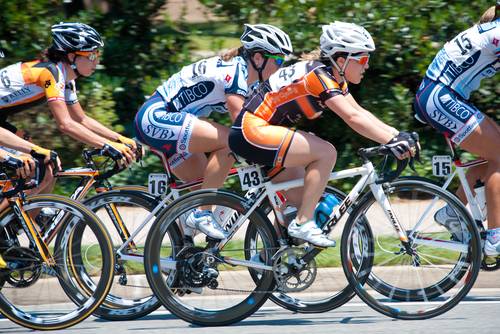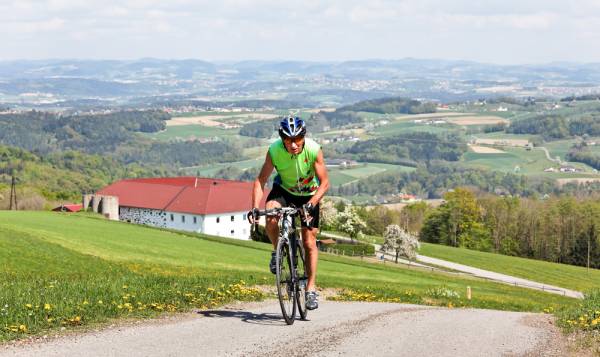Cyclists sometimes challenge me when it comes to whether or not they should be doing gym exercise. They challenge the usefulness of gym exercise for an endurance sport like cycling. Whether one is a recreational cyclist or amateur competitor, I think more power is always useful to have. Since power is defined as force times speed, more power comes about by pedalling faster for the same force, delivering more force, or a combination of the two. Even if you are not very competitive, I am sure the ability to reach your destination with less perceived effect would be attractive.
Traditionally, the off-season has been the time to get the miles in and is characterized by long slow rides. While “getting the miles in” has been the mainstay of classic endurance cycling programs, I think it is useful to look at what research has been done to support gym exercise as a basis for more powerful cycling, as well as what sort of gym exercise would be most useful. In doing the research, I was particularly interested to see if there was a comparison between going out cycling and gym exercise when it comes to performing different cycling activities. This could a real bonus to doing exercise indoors, knowing that it would be progressing the athlete toward his or her goals.
Rather than re-iterate articles from books, hearsay, and opinion, I wanted to go back to the original sources where possible. I have picked four articles for review. There are several more and some do show that for certain exercise parameters no significant benefit was detected in the type of tests that were undertaken.
The first article by Rønnestad, Hansen, and Raastad explores pre-season and in-season strength training. Two groups of cyclists were compared for cycling performance, oxygen consumption, muscle cross-section area, and strength during a twelve-week preparation phase followed by a thirteen-week in-season program. During the twelve-week preparation phase, one group followed a program of endurance and heavy strength training twice per week. The other group undertook a program of endurance training only. During the thirteen-week competition phase, the previous strength training group undertook strength maintenance training once per week. The exercises were designed to resemble cycling motion and included half squat, recumbent single leg press, standing one leg hip flexion, and ankle plantar flexion.
It is perhaps, no surprise that the leg strength increased by 23% in the weight training group and was maintained. Leg strength did not increase in the endurance group. Additionally, in forty-minute time trial tests, the strength group increased their mean power by 8% during the preparation phase and then a further 6% by the end of the competition phase. The endurance group increased mean power by 4% at the end of the preparation phase and this was not increased in the competition phase.
 A year later in 2011, Rønnestad, Hansen, and Raastad executed another test to see what would happen if cyclists undertook a longer submaximal activity of 185 minutes followed by a five-minute sprint. This might be similar to a road race with the final finish. As before, one group performed strength and endurance training, while the other group performed just endurance training. The strength group showed a lower heart rate and oxygen consumption during the last hour of the 185-minute exercise compared with the endurance group. The strength group also increased mean power output during the final five-minute sprint by 7.8% compared to no increase by the endurance group.
A year later in 2011, Rønnestad, Hansen, and Raastad executed another test to see what would happen if cyclists undertook a longer submaximal activity of 185 minutes followed by a five-minute sprint. This might be similar to a road race with the final finish. As before, one group performed strength and endurance training, while the other group performed just endurance training. The strength group showed a lower heart rate and oxygen consumption during the last hour of the 185-minute exercise compared with the endurance group. The strength group also increased mean power output during the final five-minute sprint by 7.8% compared to no increase by the endurance group.
In 2010, Sunde et. al. studied the effect of maximal strength training on cycling economy, work efficiency, and time to exhaustion between a strength training group and an endurance group. The strength group performed half squats three times per week to supplement endurance training over an eight-week period. The strength training group exhibited significant improvements in rate of force development (16.7%), cycling economy (4.8%), work efficiency (4.7%), and time to exhaustion at maximum aerobic power (17.2%). The endurance group showed a small increase in work efficiency (1.4%), but the other factors were not improved.
And back in 2005, Paton and Hopkins subjected cyclists to a combination of explosive and high intensity training during the competitive season. They found a program of explosive single leg jumps and high intensity thirty-second intervals contributed an 8.7% improvement in power during a 1km time trial, an 8.4% improvement in power during a 4km time trial, and a 6.7% improvement in peak power. The changes observed for the control group were less than 0.3%.
 One final thought is that as you get older natural processes, if left unchecked, can reduce bone density and muscle tone. Even if you are not convinced by the benefits of resistance training for cycling, if you wish to win a vets race in ten years time, you may wish you had.
One final thought is that as you get older natural processes, if left unchecked, can reduce bone density and muscle tone. Even if you are not convinced by the benefits of resistance training for cycling, if you wish to win a vets race in ten years time, you may wish you had.
In conclusion:
- Strength training during the preparation phase can improve performance more than just endurance training.
- Maintenance strength training during the competition phase can improve performance further whilst endurance training does not.
- Strength training can improve time trial performance and also longer distance oxygen economy.
- Strength training can improve the power output in a sprint finish at the end of a longer distance.
- There is benefit in performing a mixture of explosive and high intensity training.
- As usual, if you are not used to resistance training, do start gently and seek some professional advice before starting.
References:
1. B. Rønnestad. E. Hansen, and T. Raastad, “In-season strength maintenance training increases well-trained cyclists’ performance,” European Journal of Applied Physiology. 110(6): 1269-1282. (2010)
2. B. Rønnestad. E. Hansen, and T. Raastad, “Strength training improves 5-min all-out performance following 185 min of cycling,” Scandinavian Journal of Medicine & Science in Sports, 21(2): 250-259. (2011)
3. A.Sunde, O. Støren, M. Bjerkaas, M.H., Larsen, J. Hoff, and J.Helgerud, “Maximal strength training improves cycling economy in competitive cyclists.” J Strength Cond Res. 2010 Aug;24(8):2157-65.
4. Carl D. Paton and William G. Hopkins, “Combining Explosive and high resistance training improves performance in competitive cyclists,” Journal of Strength and Conditioning Research, 2005, 19(4), 826–830
Photos courtesy of Shutterstock.






